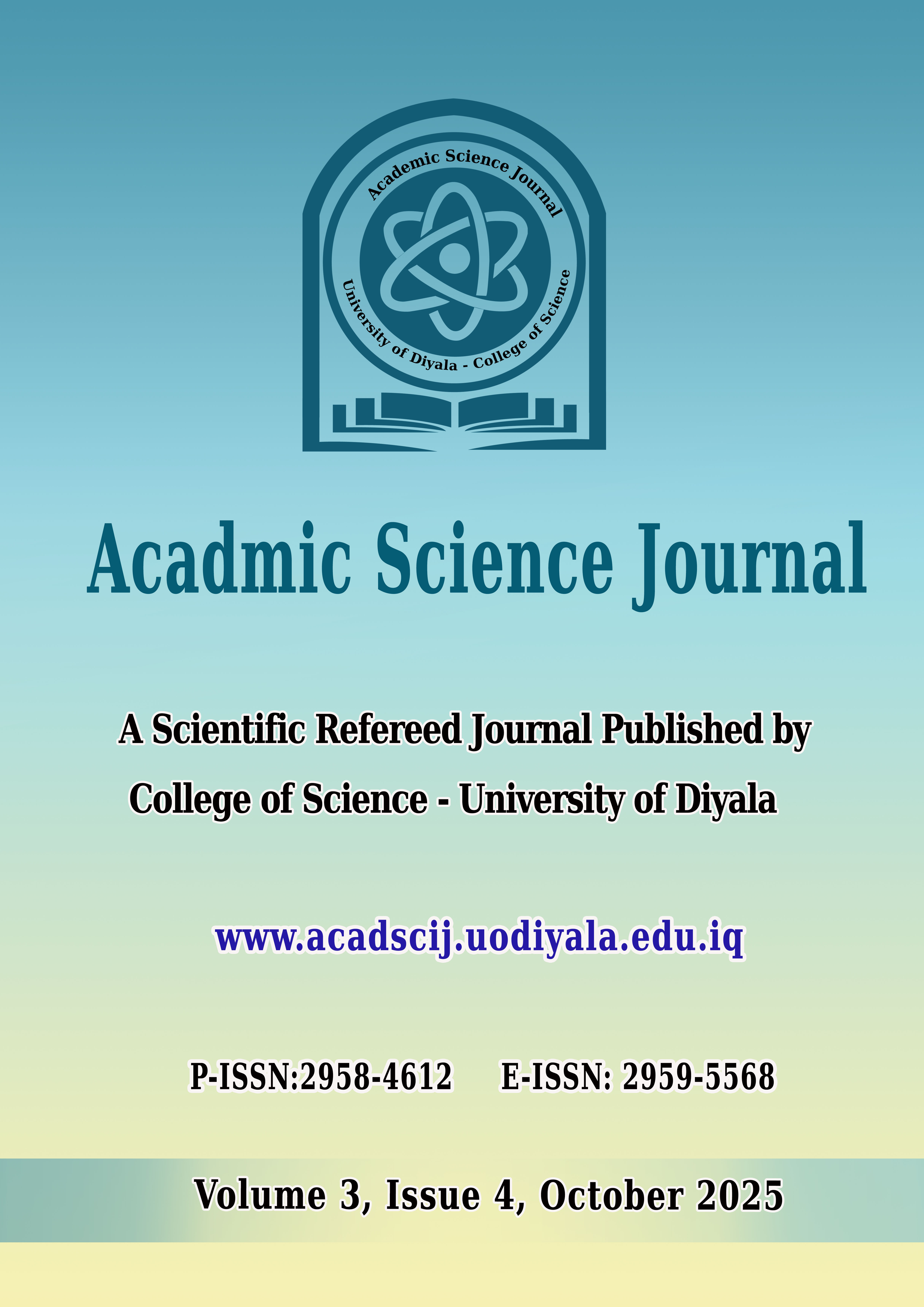Investigation of in Vitro Anti Protoscoleces of Echinococcus granulosus Activity for Cyperus rotundus Plant Extract
DOI:
https://doi.org/10.24237/ASJ.03.04.899BKeywords:
Echinococcus granulosus, Protoscoleces , Cyperus rotundusAbstract
Hydatid cyst is a continuing health problem in various parts of the world that is not linked to the economic level of countries, but rather linked to adherence to health conditions. Therefore, both animals and humans are still at risk of infection. The study was conducted to evaluate the effect of the boiled water extract of Cyperus rotundus on the viability of Echinococcus granulosus protoscoleces in vitro as an environmentally friendly means of controlling the disease.
Livers were collected from the slaughtered animals at the butchers’ shops )cows and sheep) infected with hydatid cysts from different areas, including butchers’ Baladruz and Baquba in Diyala province. The concentrated suspension of protoscoleces was added to different concentrations of the boiled water extract of Cyperus rotundus root at different concentrations (100, 50, 25, 12.5 mg/ml), and for different time periods (5, 4, 3, 2, 1, 30 hours), and the viability of these protoscoleces was measured using 0.1% aqueous eosin stain.
The results of the current study showed that the mortality rate of protoscoleces was associated with an increase in the concentration of the plant extract and the exposure time. The highest mortality rate (100%) was at the highest concentration of 100 mg/ml within 240 minutes, while the lowest mortality rate (34.54%) was at the concentration of 12.5 mg/ml and within half an hour (30 minutes). The differences in mortality rates of protoscoleces at different concentrations and different exposure times were significant at (p<0.05).In conclusion, The extract has a potential therapeutic ability and can be used to treat and treat cysts.
Downloads
References
. S. Elshahawy, M. A. El-Seify, Z. K. Ahamed, and M. M. Fawaz, Occurrence and Phylogenetic Description of Cystic Echinococcosis Isolate from Egyptian Camel (Camelus Dromedarius), Helminthologia, 59, 253–264(2022), DOI(https://doi.org/10.2478/helm-2022-0026)
[2] N. I. Toaleb, M. S. Helmy, E. E. El Shanawany, and E. H. Abdel-Rahman, A simple an efficient purification method of native immunoreactive antigen for diagnosis of camel hydatidosis, Vet. World, 13, 141–146(2020), DOI(https://doi.org/10.14202/vetworld.2020.141-146)
[3] K. S. Al-Mayah, N. M. Al-Bashir, and B. M. Al-Azzawi, In vivo efficacy of Nigella sativa aqueous seed extract against metacestode of Echinococcus granulosus, Medical journal of Babylon, 9(1), (2012)
[4] R. M. Samra, A. F. Soliman, A. A. Zaki, A. Ashour, A. A. Al-Karmalawy, and M. A. Hassan, Bioassay-guided isolation of a new cytotoxic ceramide from Cyperus rotundus L., S. J Bot,139, 210–216(2021), DOI(https://doi.org/10.1016/j.sajb.2021.02.007)
[5] A. M. Fahmy, A. M. Alshenawy, E. A. El-Wakil, and A. M. Hegab, Efficacy of Cyperus rotundus extract against cryptosporidiosis and toxoplasmosis in murine infections, Egypt Pharm J, 20, 24(2021), DOI(https://doi.org/10.4103/epj.epj_27_21)
[6] A. Kamala, S. K. Middha, and C. S. Karigar, Plants in traditional medicine with special reference to Cyperus rotundus L.: a review, Biotech, 8(7), 309(2018), DOI(https://doi.org/10.1007/s13205-018-1328-6)
[7] A. L. Molan, M. Q. Balasim, and N. Y. Al-Bayati, Insecticidal Activity of Grape Pomaces from Two Grape Cultivars Against the Housefly (Musca domestica L.) Under Laboratory Conditions, Trop Life Sci Res, 29(2), 89-102(2018), DOI(https://doi.org/10.21315/tlsr2018.29.2.7)
[8] N. J. A. Al-Rikabi, The effect of Cyperus rotundus extracts and Trigonella foenum leaves on the vitality of the primary heads of Echinococcus granulosus outside the body, Dhi Qar University Journal, 7(4), 1-11(2012)
[9] F. A. Al-Hilli, Study of Antimicrobial effect of leaves extract from Callistemon citrinus on Pseudomonas aeruginosa isolated from patients, M.Sc. Thesis, Coll.Sci.,Univ.Al-Mustansiriya, (2000)
[10] A. I. Elshamy, A. H. Farrag, I. M. Ayoub, K. A. Mahdy, R. F. Taher, and E. I. Gendy, UPLC-qTOF-MS phytochemical profile and antiulcer potential of Cyperus conglomeratus rottb alcoholic extract, Molecules, 25, 4234(2020), DOI(https://doi.org/10.3390/molecules25184234)
[11] J. J. L. Bezerra, and A. A.V. Pinheiro, Traditional uses, phytochemistry, and anticancer potential of Cyperus rotundus L. (Cyperaceae): A systematic review, S Afr J Bot. , 144, 175–186(2022), DOI(https://doi.org/10.1016/j.sajb.2021.08.010)
[12] S. B. Babiaka, D. E. Ekayen, D. L. Njimoh, and K. O. Abuga, Bioactive Compounds and Biological Activities of Cyperus rotundus L. (Cyperaceae), In: Murthy, H. N.;Paek, K.Y. and Park, S-Y. Bioactive Compounds in the Storage Organs of Plants, Springer, (2023), DOI(https://doi.org/10.1007/978-3-031-29006-0)
[13] M. M. Cowan, Plant Products As Antimicrobial Agents, Clin. Micro. Rev., 12(4), 564- 582(1999), DOI(https://doi.org/10.1128/cmr.12.4.564)
[14] A. Lobiuc, N. E. Pavăl, G. R. Mangalagiu II, G. C. Teliban, D. Amăriucăi-Mantu, and V. Stoleru, Future Antimicrobials: Natural and Functionalized Phenolics, Molecules., 22, 28(3), 1114(2023), DOI(https://doi.org/10.3390/molecules28031114)
[15] M. Adak, and P. Kumar, Herbal anthelmintic agents: a narrative review, J Tradit Chin Med., 42(4), 641-651(2022), DOI(https://doi.org/10.19852/j.cnki.jtcm.2022.04.007)
[16] B. H. Shnawa, Sh. M. Gorony and K. M. Khalid, Efficacy of Cyperus rotundus rhizomes – tubers extracts against protoscoleces of Echinococcus granulosus, World Journal of Pharmaceutical Research, 6(8), 157-179(2017)
[17] J. Carrique-Mas, N. Iihoshi, and M. A. Widdowson, An epidemiological Study ofTaenia solium cysticercosis in a rural population in the Bolivian Chaco, Acta Trop., 80, 229-235(2001), DOI(https://doi.org/10.1016/S0001-706X(01)00161-9)
Downloads
Published
Issue
Section
License
Copyright (c) 2025 CC BY 4.0

This work is licensed under a Creative Commons Attribution 4.0 International License.




